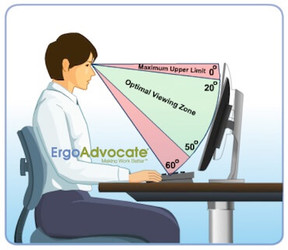Eye Strain, Neck Pain and Monitor Ergonomics (Conventional Wisdom vs Ergonomics Evidence)
Posted by Gene Kay, MS CPE on 25th Jul 2017
Perhaps nothing is more common among computer users than eye-strain and neck pain. And ironically, at the same time, perhaps nothing is more controversial than suggesting a change to the conventional way of placing the monitor.
In 1997 the OSHA ergonomics user guide, Working Safely with Video Display Terminals (OSHA 3092), reported that “Visual problems such as eyestrain and irritation are among the most frequently reported complaints by VDT operators. These visual symptoms can result from improper lighting, glare from the screen, poor positioning to the screen itself, or copy material that is difficult to read. These problems usually can be corrected by adjusting the physical and environmental setting where the VDT users work.”
Fast-forward 15 years and we see that little has changed: The Mayo Clinic web site says “Using a computer for long periods is one of the most common causes of eyestrain.” And, we see that 60-70% of all participants in the ErgoAdvocate on-line program report eye strain and neck pain as one of the reasons for seeking ergo assistance. Given this high prevalence of discomfort and seeming lack of progress over the years and you might begin to wonder if the right message and advice is being communicated to the public.
Conventional Wisdom for Monitor Placement: Ask an health or ergonomics practitioner for suggestions on dealing with eye strain and neck pain, and you will likely be advised to maintain an upright seated posture with the monitor placed near eye-level. The goal of the conventional wisdom is to keep the neck in an upright neutral neck posture. The conventional wisdom seems to be that, if you’ve got neck pain, your monitor is probably too low.
Good for the Neck, Bad for the Eyes: The conventional wisdom for monitor placement seeks to maintain an upright neutral posture in the neck. The assumption is that the proper viewing angle is perpendicular to the spine - the eyes look out straight, and bending the neck is how computer users change eye position when reading. This is a flawed and simplistic understanding of how the eyes and neck work when reading. This upright posture and the horizontal viewing angles necessitated by high monitor placement cause extra strain on the visual system, and may result in neck extension (bending back) to relieve the eye strain.
The Missing Link- Optimal Positioning for the Eyes: The visual system is controlled by a collection of small muscles surrounding the eyes. They must actively work to focus the eyes and to maintain aim at the visual target. These muscles can be easily over-worked if the reading material is too close or too high.
- Eye strain from accommodation — near viewing text or objects closer than approximately 40 inches/ 100 cm requires the muscles surrounding the eyes to contract to maintain focus. Placing the monitor closer increases the strain from visual accommodation.
- Eye strain from convergence — the eyes must converge (turn in towards each other) for near viewing. Without convergence you get double vision. The closer the display screen or object being viewed, the more strain from convergence. Convergence is much easier for the eyes with a downward gaze angle. Convergence is much harder with an upright horizontal viewing angle.
- Eye strain from dry eyes — horizontal viewing results in the eyes opening very wide. The eye lids have further to travel to close, resulting in an incomplete blink and more of the eye exposed to dry in the air.
The Optimal Viewing Angle for the eyes, according to the International Standards Organization (ISO ergonomics standards 9241-5), is a -35 degree downward gaze angle from the horizon. And the optimal monitor placement is +/- 15 degrees from this resting angle. Based on this data, the active monitor or screen should be placed between -20 degrees and -50 degrees relative to the horizon. This is lower than most users are accustomed for computer work, but is near the ”normal” reading position successfully used by humans for thousands of years. In this normal reading position our monitor or other source material (iPad, paper, books, magazines, etc.) should be near chest-height rather than the conventional head-height as seen for the typical monitor set up.
The Upper and Lower limits: The ISO standard allows for visual work to be performed anywhere from a 0 degree horizontal gaze, all the way down to -60 degrees gaze angle. Be aware that this upper 0 degree angle, if performed for long periods, may well result in eye strain, and the lower -60 degree angle may result in neck strain.
Summary Recommendations:
- Head up, eyes down. Striving for an upright neutral neck posture is a fine objective, but allow for a downward gaze with the eyes to reduce eye strain.
- Further than 25 inches/ 65 cm is best. Keeping the monitor or other source material further away reduces the strain of accommodation. The simple keyboard shortcut “Ctrl” & “+” (for PCs) can increase screen image size and allow for comfortable viewing from a greater visual distance.
- Change positions and move. Use the 30-30-30 rule; every 30 minutes take a 30 second break and look 30 yards/ meters in the distance.
Adapted from D. R. Ankrum and the www.office-ergo.com web site. This is an updated version of content originally published in The Ergonomics Report™ on July 19, 2011.
Originally published on ergoweb.com September 2, 2014.

